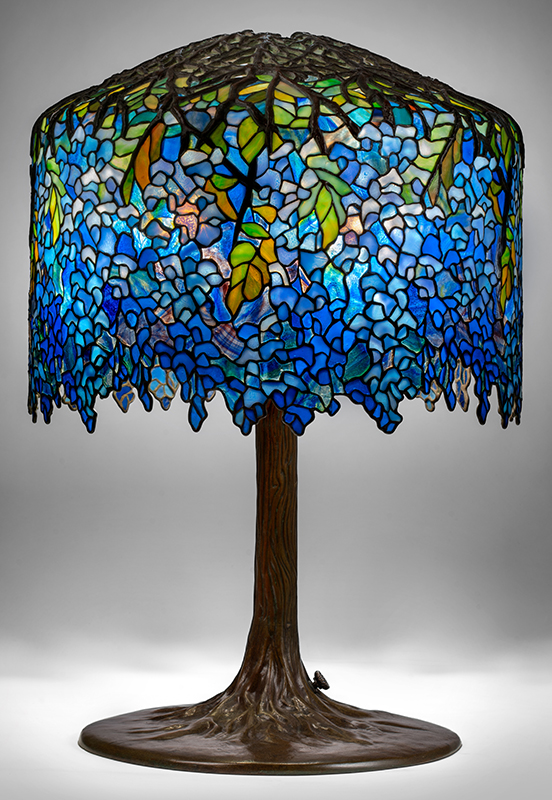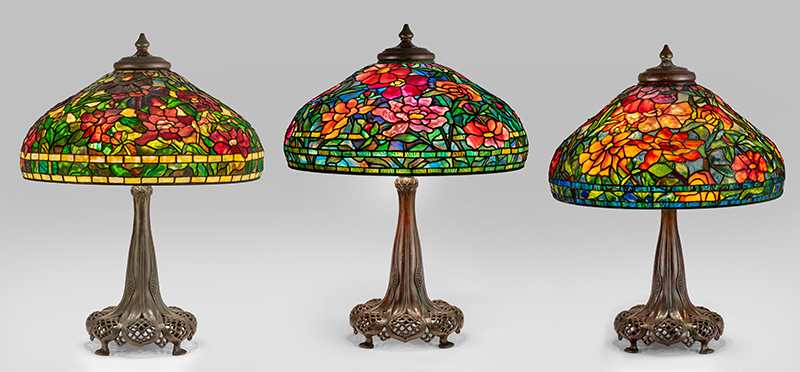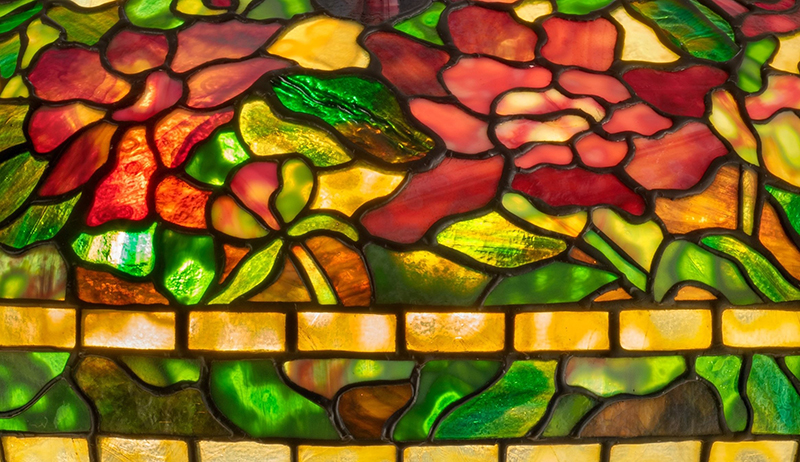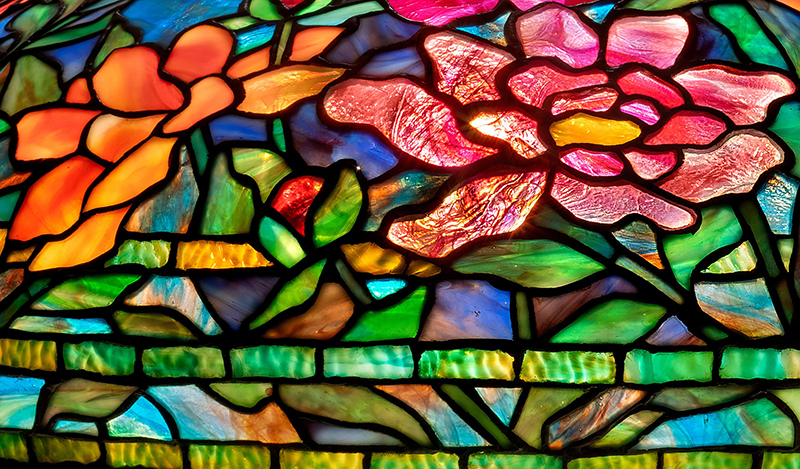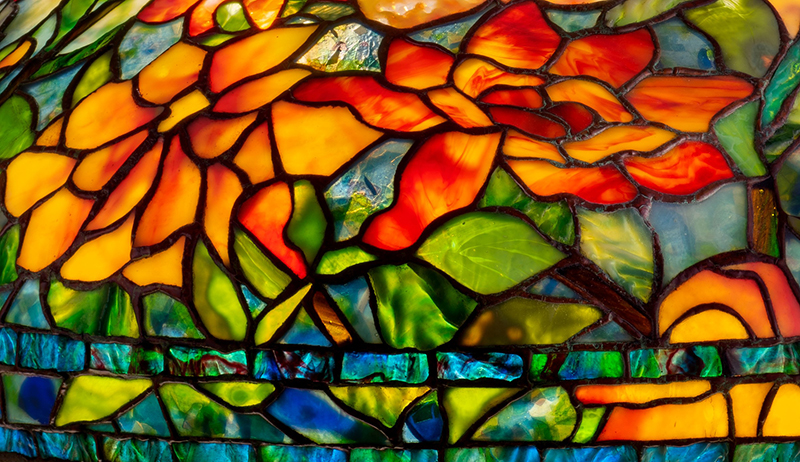Tiffany or Tiphony? The Art of Connoisseurship
by Lindsy R. Parrott
Can you tell the difference between an authentic Tiffany lamp and a forgery? That question—and challenge—is the focus of Tiffany or Tiphony? The Art of Connoisseurship, a new traveling exhibition organized by the Neustadt Collection of Tiffany Glass in Queens, NY.
We were pleased to welcome Decorative Arts Trust members for a virtual tour of The Neustadt’s collection during a virtual Americana Week visit in January. Renowned for its collection of more than 100 Tiffany lamps, The Neustadt’s holdings also include an important study collection of forgeries (figure 1). Many of these fake shades and bases are incredibly convincing; so convincing, in fact, that they were mistakenly purchased by museum founder and early Tiffany collector, Dr. Egon Neustadt, during his decades-long collecting career.
From the purchase of his first Tiffany lamp in 1935 until his death in 1984, Dr. Neustadt built the largest and most encyclopedic collection of Tiffany lamps ever assembled.1 Comprised of more than 200 examples, his collection ranges from one-of-a-kind lamps to multiple examples of a single design. With no roadmap for collecting, he developed his connoisseurship skills as he went, inevitably making a few mistakes along the way.2
The vast majority of lamps Dr. Neustadt purchased were acquired in the 1950s and 1960s, before public interest in Louis C. Tiffany’s work was revived and widespread—and before there was money to be made by selling forgeries. One can’t fault Dr. Neustadt for being taken in by some of these fakes: they are beautiful and, often, well made; additionally, each bears a convincing signature. So how do you tell a real lamp from a fake? What should you look out for?
Tiffany or Tiphony? seeks to address those questions with 50 lamps that illustrate many of the characteristics differentiating an authentic Tiffany lamp from a forgery—colloquially referred to as a “Tiphony.” Through a close examination and comparison of 36 authentic lamps and 17 convincing forgeries, visitors will face many of the same questions Dr. Neustadt grappled with as he built his collection.
The first section of the exhibition, “Hallmarks of a Tiffany Lamp,” explores the hallmarks of authentic examples (figure 2). The table lamps, floor lamps, and hanging shades featured in this section introduce visitors to the diversity of designs, shapes, styles, and color palettes found in Tiffany’s lighting fixtures. A model illustrating the labor-intensive process of making a leaded-glass lampshade, and an assortment of original flat glass drawn from The Neustadt’s one-of-a-kind Tiffany Glass Archive, is also included.
Section two, “Tiffany vs. Tiphony,” juxtaposes twin pairs of authentic and counterfeit lamps. Comparing and contrasting each of these pairings, six in total, illustrates a different factor to carefully consider when assessing authenticity, including shade design, glass selection, glass type, color palette, soldering technique, and bronze casting. These one-to-one comparisons provide an intimate and revealing look at what is right, and what is wrong, with each lamp on display.
The third and final section, “Can You Spot the Tiphony?,” gives visitors the opportunity to test their skills of observation. Several examples of a single floral lamp design, including Wisteria, Pond Lily, and Laburnum, are displayed in groups. Visitors are challenged to use their newfound knowledge to determine which of the lamp examples are counterfeit. For instance, in a grouping of three Peony lamps, only one example is real (figure 3). A careful study of the lampshades reveals significant differences in the “Peony” design, such as a missing geometric border and additional petals added to blossoms (figures 4–6). In a display of six Wisteria lamps, the forgeries are trickier to distinguish, only revealing themselves through assessing glass selection. In one example, the shade’s background, or spaces between the blossom clusters, is a strongly textured glass, something not seen in original Wisteria examples. In the other fakes, the color palette is a little “off”: some of the blossoms are an unusual muddy purple, for instance, or the foliage is a surprisingly discordant green. Each of these characteristics break the harmonious balance of color and textures found in real Tiffany lampshades (see figure 1).
Tiffany or Tiphony? is an exhibition about discernment and connoisseurship rather than the art of the forgery. Visitors are invited to actively engage with the objects on display by scrutinizing, assessing, and comparing, rather than passively admiring the beauty of Tiffany’s lamps. Thanks to the extraordinary breadth and depth of Dr. Neustadt’s collection, this exhibition offers the unprecedented opportunity to simultaneously compare, side by side, multiple examples of a single lamp design and to develop an appreciation for the fine art of connoisseurship. Can you spot the forgeries in figure 1?
1 In 1969, Dr. Neustadt established a museum—today named the Neustadt Collection of Tiffany Glass—to share his vast collection. He divided his lamp collection between his museum and the New-York Historical Society following a major exhibition of his holdings in 1983 at the N-YHS.
2 Louis C. Tiffany’s work fell deeply out of fashion following his death in 1933. Dr. Neustadt was among a handful of early collectors, dealers, and scholars who revitalized interest in Tiffany’s work in the mid-20th century. In 1970, Dr. Neustadt published The Lamps of Tiffany, the first book devoted to the subject.
Lindsy R. Parrott is the Executive Director and Curator of the Neustadt Collection of Tiffany Glass. Tiffany or Tiphony? The Art of Connoisseurship, launching in early 2022, is co-curated by Lindsy and Morgan Pruden, Assistant Curator and Special Projects Manager. Check www.neustadt.org for updates about exhibition dates and locations.
The Neustadt was part of the Decorative Arts Trust’s virtual Americana Week. Watch the recording on our YouTube channel.
A print version of this article was published in The Magazine of the Decorative Arts Trust, one of our most popular member benefits. Join today!


